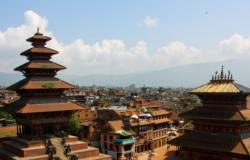Aid has boosted Nepal’s Education and Health Sector

Foreign aid has helped Nepal make headway in the health and education sector in the past decade. But the earthquakes in April and May 2015 and the insufficent response by Nepal’s newly elected government have led to serious setbacks. They cast doubt among donors and the international community.
Following the passing of the new constitution in September of last year, the first of its kind in Nepal that was decided on by a democratically chosen assembly, Nepal’s parliament elected Sharma Oli as prime minister on 11 October 2015.
Oli is now faced with a herculean task: leading Nepal’s recovery after the devastating earthquakes that had hit the country in April and May 2015, fostering the reconciliation between casts and alleviating tensions with the Southern neighbor, India, are all on the agenda.
Above all, Oli has to get the Himalayan country off the ground and lose its status as one of the least developed countries in the world.
Nepal’s government is heavily reliant on development aid
Governments in Nepal have relied on development aid for decades. Since 2005, official development assistance (ODA) averaged 34% of all government expense. The Oli government will be no exception.
At first sight, decades of international aid have not produced better governance in Nepal. The country remains one of the poorest and least developed countries in the world. With a per capita GNI of $730, Nepal ranks 145th out of 188 countries in the 2015 Human Development Index (HDI).
Since the end of the Maoist insurgence in 2006, governance has been poor. The Bertelsmann Transformation Index (BTI), a governance assessment tool covering 129 countries, rates Nepal at 3.0 and 3.3 on a 1-10 scale in the “resource efficiency” and “steering capability” criteria. Both ratings will drop by 0.3 in the forthcoming BTI 2016 which will be released in February. The country clearly lacks a coordinated long-term approach for economic growth.
All of the above suggests that aid in Nepal is ineffective, misused and wasted. Understandably, the poor results and the lack of progress have led to frustrations among donors and the Nepali people.
International assistance has helped Nepal work towards Millennium Development Goals
However, there are serious indications that foreign aid is playing a positive role for Nepal’s political and economic transformation. In the BTI 2016, Nepal receives a respectable score of 6 in the indicator “effective use of (international) support”. This rating reflects a better performance than, say, that of Bosnia and Herzegovina, Lebanon or Thailand.
To some extent, Nepal has been successful in using international assistance for its own development agenda. This is nowhere more evident than when we take a closer look at the success Nepal has had in working towards achieving the United Nation’s Millennium Development Goals (MDG), especially the second MDG, achieving universal primary education, and the fourth MDG, reducing child mortality.
From 2005 to 2012, around 12% of all ODA went to the health sector, and, according to the World Bank, between 40 and 50% of total government expenditure on health consisted of ODA.
The education sector attracted an even larger share of ODA (17%), nearly equivalent to the amount of aid spent on Nepal’s infrastructure. While the latter has obviously suffered due to the earthquakes and will attract a large share of ODA in the future, the investments in the education and health sector have borne fruit and could pay off in the long-term.
Between 2000 and 2013, Nepal has reduced its under-five mortality rate by more than half, down to 40 per 1,000 live births. Life expectancy at birth has increased from 62 to 68 years. Literacy rate of people aged between 15 and 24 stands at 86% in 2015, a significant improvement compared to 70.1% in 2000. Equally encouraging, primary school enrolment rose up to 98% and primary completion stood at 100% in 2014.
Efforts for more aid effectiveness
Nepal’s government embraced the aims of the MDGs and shaped its development policies in direct endorsement of all eight goals. It implemented the Aid Management Platform in an attempt for more transparency and aid effectiveness.
These measures have all worked to a certain degree. The upcoming BTI points out that in association with a large host of international partners Nepal has produced ”good results, especially in the areas of education, health, drinking water, telecommunications, road construction and power generation." Certainly, by far the most improvements were noted in the health and education sector.
Considering the unstable political situation during the last decade these improvements are certainly impressive and a reason to hope that, with the situation now resolved, progress lies ahead.
Nepal’s new government needs international help
Despite the uncertainty, past success in spreading education and improving the health situation of Nepal’s citizens should encourage donors to continue their financial engagement.
Prime Minister Oli has to plan for the long-term. He has to limit bad governance and rent-seeking, while also addressing the continuous stagnation on the socioeconomic front.
Before the new administration can even begin to tackle these problems, as well as the pressing issue of poverty among the less privileged castes, the Oli government will have to address the recovery effort. The new prime minister needs the help of the international community.
Marvin Jérôme Hanke is research assistant at the Bertelsmann Stiftung’s Transformation Index (BTI). He studied Political Science and English at Bielefeld University and the University of Zurich.


